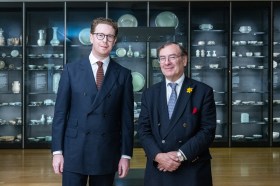Russia is vast. Vast like the Universe. Vast in a way almost impossible for someone born and bred in Britain to believe. From Lands End to John O’Groats you can buy the same copy of The Times at the same time: there are eleven time zones in Russia. If Russia were a Russian doll you could fit Europe and the USA inside her and still have room to spare for five Germanys. How can a country be in Europe and have borders with China, Japan and Mongolia?
These are the questions and contradictions that Russia and her rulers have been wrestling with for centuries. The Romanov royal family’s crest was a double-headed eagle looking east and west, a mythical metaphor for an unlikely country impossible to fathom. That same eagle appears on Faberge’s famous eggs, themselves as fragile as the brittle relationship between Britain and Russia that almost scuppered the Royal Academy’s flagship winter exhibition: From Russia.
The first thing that strikes you about the spellbinding nine room show is the clue given in its title: the art may be from Russia but that don’t make it Russian art. Until Napoleon marched eastwards, Russian aristocrats only spoke to each other in French. The exhibition includes works by Chagall, Cezanne, Monet and, my personal favourite, Matisse’s The Dance. No matter how many pictures, posters or films of the Eiffel Tower you’ve seen, nothing prepares you for the jolt of wonder the first time you set eyes on the real thing and it’s the same with The Dance.
The very familiarity of the French masterpieces on offer renders the Russian paintings all the more foreign and otherworldly. The primary colours, harsh lines and haunted faces on the walls remind us how little we know about our giant neighbour. It is chastening to think that this exhibition may be a fleeting glimpse behind the iron curtain before it comes down once again.
The final room contains a nightmarish Orwellian film that imagines Tatlin’s Tower had actually been built in St Petersburg. Tatlin’s Tower was planned during the revolution of 1917 and would have housed the Comintern (the body dedicated to spreading Communism around the world). The design is a brutal steel drill enclosed in a cruel cage and standing two thirds as large again as the Eiffel Tower but many times more terrifying.
I wonder what else we can expect from Russia in the years to come.
From Russia runs at the Royal Academy until 18 April 2008.




